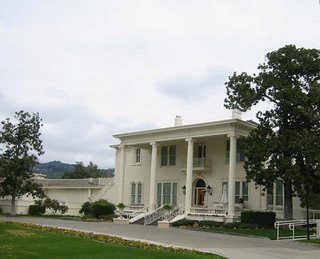How I spent my Mid-Autumn Festival
A thought occured to me as I stared at the 12%-larger-than-normal full moon on Friday. Where did the design of No. 16 come from? I mean, where did it really come from?
In this year's personal statement, I wrote about my dad being a great Elvis fan, who built his home to model that of Graceland, "pillars and all". Here is a picture of the front:

Granted the picture could show the pillars a bit better, but trust me, they're there. I can't help if the palm trees are 12 years old and are nice and tall.
Here is a picture of Graceland:

Do you see the similarities? There' s the pillars, the windows, and the large balcony. I never thought our house looked that much like Graceland, except for the pillars and, as it turns out, my dad clarified the matter this past weekend. While No. 16 is inspired by Graceland, the house was more accurately modeled after the Silverado Country Club & Resort in Napa Valley (built in the 1870s), which was featured in the 80s TV show, Falcon Crest (a show my dad watched). On the show, this location was known as the Del Oro Spa & Country Club.
Here are two pictures of the front of the Silverado, as well as a side view:


A thought occured to me as I stared at the 12%-larger-than-normal full moon on Friday. Where did the design of No. 16 come from? I mean, where did it really come from?
In this year's personal statement, I wrote about my dad being a great Elvis fan, who built his home to model that of Graceland, "pillars and all". Here is a picture of the front:

Granted the picture could show the pillars a bit better, but trust me, they're there. I can't help if the palm trees are 12 years old and are nice and tall.
Here is a picture of Graceland:

Do you see the similarities? There' s the pillars, the windows, and the large balcony. I never thought our house looked that much like Graceland, except for the pillars and, as it turns out, my dad clarified the matter this past weekend. While No. 16 is inspired by Graceland, the house was more accurately modeled after the Silverado Country Club & Resort in Napa Valley (built in the 1870s), which was featured in the 80s TV show, Falcon Crest (a show my dad watched). On the show, this location was known as the Del Oro Spa & Country Club.
Here are two pictures of the front of the Silverado, as well as a side view:


No. 16 has aspects from both locations: white paint, large windows, sprawling garden in front with palm trees, a central balcony and distinctly triangular roof.
So if Graceland and Silverado inspired the design of my parents' house, what inspired their designs? According to architectural history, these designs are known as American Greek Revival architecture. The classic trademark of these designs is the white pillars. This syle became widely popular on the East Coast during the late 18th and early 19th century. Its increasing widespread use is distinctly related to America's independence. The citizens and government of the new US of A wanted their buildings and structures, monuments and landmarks, to reflect their newly acquired democratic status. Aptly so, Greek and Roman designs (whose cultures are perceived as the Founders of Democracy) were mimicked to help express the new status of America in its architecture. The Greek Revival style is considered to be America's first "national architectural style".
A similar movement occured in Europe, where there was growing interest in ancient Greek art. Here is a passage I wiki-ed that talks about the influence of ancient Greek architecture: "In the wake of European interest in Greek art, America shirted from Roman forms toward the Greek style in the 1820s. This was caused by many factors: The War of 1812 caused Americans to feel contempt toward anything British, including architecture. The Roman, or Federal style, was no longer favored. Greece was now looked upon as the true home of Democracy, and the Mother of Rome."
As an example to illustrue the "Mother of Rome" point, here is a picture of the Pantheon, an ancient Roman temple:
And here is the Parthenon, a 2,500-year-old Greek structure, at least five centuries older than the Pantheon itself:
 From Wikipedia: "The Parthenon (ancient Greek:Παρθενών) was a temple of Athena, built in the 5th century BC on the Acropolis of Athens. It is the best-known remaining building of Ancient Greece, and has been praised as the finest achievement of Greek architecture. Its decorative sculpture is considered one of the high points of Greek art. The Parthenon is an enduring symbol of Ancient Greece and of the Athenian democracy, and it is regarded as one of the world's greatest cultural monuments."
From Wikipedia: "The Parthenon (ancient Greek:Παρθενών) was a temple of Athena, built in the 5th century BC on the Acropolis of Athens. It is the best-known remaining building of Ancient Greece, and has been praised as the finest achievement of Greek architecture. Its decorative sculpture is considered one of the high points of Greek art. The Parthenon is an enduring symbol of Ancient Greece and of the Athenian democracy, and it is regarded as one of the world's greatest cultural monuments."
Now that you've come this far, return to the start of the post and scroll down, looking only at the images.
What struck me profoundly on Friday, as I stared at the shiny round moon in the sky, was this: How amazing it is that because of global communications, because of an increasingly well-connected, smaller world, an architectural design that is 25 centuries old has traversed all across Europe, spanned the Atlantic to the US East Coast, hopped along to the Pacific, and found its way to my tiny home country, to inspire the architectural designs of No. 16.
I love how this house, with its white pillars, triangular/angular design, and sprawling size is ultimately an expression of our desire to capture our own piece of history, and that this piece of history is an "enduring symbol" that is thousands of years old. It moves me to know how ancient the design of No. 16 really is. It moves me even more to know that because we have television, the Internet, cameras, because we have architects and design schools, we are able to build our own Parthenons.
No offense to those other house owners back home who have tried valiently (but weren't often successful) to imiate the house's design. Being biased, I believe that No. 16 is the best looking one and was the first of its kind back home. Know this, folks: you didn't just borrow the design of Graceland; it's far more than that.
Oh, and you need better architects.
And that's how I spend my 中秋节. Didn't get to eat any mooncakes, though, how sad is that?
Copyright 2006©. All works are the original creation of the author.
So if Graceland and Silverado inspired the design of my parents' house, what inspired their designs? According to architectural history, these designs are known as American Greek Revival architecture. The classic trademark of these designs is the white pillars. This syle became widely popular on the East Coast during the late 18th and early 19th century. Its increasing widespread use is distinctly related to America's independence. The citizens and government of the new US of A wanted their buildings and structures, monuments and landmarks, to reflect their newly acquired democratic status. Aptly so, Greek and Roman designs (whose cultures are perceived as the Founders of Democracy) were mimicked to help express the new status of America in its architecture. The Greek Revival style is considered to be America's first "national architectural style".
A similar movement occured in Europe, where there was growing interest in ancient Greek art. Here is a passage I wiki-ed that talks about the influence of ancient Greek architecture: "In the wake of European interest in Greek art, America shirted from Roman forms toward the Greek style in the 1820s. This was caused by many factors: The War of 1812 caused Americans to feel contempt toward anything British, including architecture. The Roman, or Federal style, was no longer favored. Greece was now looked upon as the true home of Democracy, and the Mother of Rome."
As an example to illustrue the "Mother of Rome" point, here is a picture of the Pantheon, an ancient Roman temple:

And here is the Parthenon, a 2,500-year-old Greek structure, at least five centuries older than the Pantheon itself:
 From Wikipedia: "The Parthenon (ancient Greek:Παρθενών) was a temple of Athena, built in the 5th century BC on the Acropolis of Athens. It is the best-known remaining building of Ancient Greece, and has been praised as the finest achievement of Greek architecture. Its decorative sculpture is considered one of the high points of Greek art. The Parthenon is an enduring symbol of Ancient Greece and of the Athenian democracy, and it is regarded as one of the world's greatest cultural monuments."
From Wikipedia: "The Parthenon (ancient Greek:Παρθενών) was a temple of Athena, built in the 5th century BC on the Acropolis of Athens. It is the best-known remaining building of Ancient Greece, and has been praised as the finest achievement of Greek architecture. Its decorative sculpture is considered one of the high points of Greek art. The Parthenon is an enduring symbol of Ancient Greece and of the Athenian democracy, and it is regarded as one of the world's greatest cultural monuments."Now that you've come this far, return to the start of the post and scroll down, looking only at the images.
What struck me profoundly on Friday, as I stared at the shiny round moon in the sky, was this: How amazing it is that because of global communications, because of an increasingly well-connected, smaller world, an architectural design that is 25 centuries old has traversed all across Europe, spanned the Atlantic to the US East Coast, hopped along to the Pacific, and found its way to my tiny home country, to inspire the architectural designs of No. 16.
I love how this house, with its white pillars, triangular/angular design, and sprawling size is ultimately an expression of our desire to capture our own piece of history, and that this piece of history is an "enduring symbol" that is thousands of years old. It moves me to know how ancient the design of No. 16 really is. It moves me even more to know that because we have television, the Internet, cameras, because we have architects and design schools, we are able to build our own Parthenons.
No offense to those other house owners back home who have tried valiently (but weren't often successful) to imiate the house's design. Being biased, I believe that No. 16 is the best looking one and was the first of its kind back home. Know this, folks: you didn't just borrow the design of Graceland; it's far more than that.
Oh, and you need better architects.
And that's how I spend my 中秋节. Didn't get to eat any mooncakes, though, how sad is that?
Copyright 2006©. All works are the original creation of the author.


1 Comments:
if you spent your mid-autumn thinking about such things, then it was way better spent than just eating mooncakes.
-yannchong
Post a Comment
<< Home